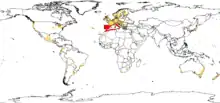Cymbalaria muralis
Cymbalaria muralis, commonly called ivy-leaved toadflax[3] or Kenilworth ivy,[4] is a low, spreading, viney plant with small purple flowers, native to southern Europe. It belongs to the plantain family (Plantaginaceae), and is introduced in North America, Australia, and elsewhere. The flower stalk is unusual for seeking light until it is fertilized, after which it grows away from the light. Other names include coliseum ivy,[4] Oxford ivy,[4] mother of thousands,[4] pennywort,[4] and wandering sailor.[4]
| Cymbalaria muralis | |
|---|---|
 | |
| Plant habit | |
| Scientific classification | |
| Kingdom: | Plantae |
| Clade: | Tracheophytes |
| Clade: | Angiosperms |
| Clade: | Eudicots |
| Clade: | Asterids |
| Order: | Lamiales |
| Family: | Plantaginaceae |
| Genus: | Cymbalaria |
| Species: | C. muralis |
| Binomial name | |
| Cymbalaria muralis | |
 | |
| Occurrence records from GBIF[1] | |
| Synonyms[2] | |
|
List
| |
Description and habitat
It spreads quickly, growing up to 5 cm (2.0 in) tall – it commonly grows in rock and wall crevices, and along footpaths. The leaves are evergreen, rounded to heart-shaped,2.5 to 5 cm (1.0 to 2.0 in) long and wide, 3–7-lobed, alternating on thin stems. The flowers are very small but distinctly spurred, similar in shape to snapdragon flowers.[5] Flowers from May to September.[6]
_Cymbalaria_muralis.jpg.webp) Plant habit
Plant habit_Cymbalaria_muralis_-_Leaf.jpg.webp) Leaf
Leaf_Cymbalaria_muralis_-_flower.jpg.webp) Flower
Flower_Cymbalaria_muralis_-_fruits.jpg.webp) Fruits
Fruits
Distribution
Cymbalaria muralis is native to Mediterranean climates in south and southwest Europe, the Southern Alps, eastern Yugoslavia, southern Italy and Sicily.[7][8] It has spread throughout the world as an invasive plant, including the United States,[9] the British Isles,[10] Australia[11][12][13] and New Zealand.[13][14]
It is said to have been introduced into England by accident when a shipment of sculptures was brought to Oxford. It was first introduced early in the 17th century and was widely planted in the UK up to the 19th century.[15]
Reproduction
This plant has an unusual method of propagation. The flower stalk is initially positively phototropic and moves towards the light. After fertilisation, it becomes negatively phototropic ("scototropic") and moves away from the light. This results in seed being pushed into dark crevices of rock walls, where it is more likely to germinate.[16]
References
- GBIF.org (26 May 2018) GBIF Occurrence Download https://doi.org/10.15468/dl.85brwi Cymbalaria muralis P.Gaertner, B.Meyer & Scherb.
- "The Plant List: A Working List of All Plant Species". Retrieved 9 February 2015.
- BSBI List 2007 (xls). Botanical Society of Britain and Ireland. Archived from the original (xls) on 2015-06-26. Retrieved 2014-10-17.
- "Cymbalaria muralis". Germplasm Resources Information Network. Agricultural Research Service, United States Department of Agriculture. Retrieved 9 February 2015.
- David S. MacKenzie (2002). Perennial Ground Covers. Timber Press. p. 121. ISBN 978-0-88192-557-9.
- Webb, D.A., Parnell, J. and Doogue, D. 1996. An Irish Flora. Dundalgan Press (W. Tempest) Ltd. Dundalk/. ISBN 0-85221-131-7
- Mariola Truchan; Zbigniew Sobisz (2006). "Distribution of Cymbalaria muralis P. Gaertn., B. Mey. & Scherz. in the central part of Polish Pomerania" (PDF). Biodiversity Research and Conservation. 1–2: 98–101.
- Ewa Szczęśniak; Krzysztof Świerkosz (2003). "Cymbalaria muralis P. Gaertn., B. Mey. & Schreb. and Cymbalarietum muralis Görs 1966 in Lower Silesia – expansion or regression?". In A. Zając; M. Zając; B. Zemanek (eds.). Phytogeographical Problems of Synanthropic Plants. Jagiellonian University. pp. 185–193. ISBN 8391516148.
- "Cymbalaria muralis". USDA Plants Profile. United States Department of Agriculture. Retrieved 30 June 2013.
- A. R. Clapham; T. G. Tutin; E. F. Warburg (1968). Excursion Flora of the British Isles. Cambridge University Press. ISBN 0-521-04656-4.
- Florabase: "Cymbalaria muralis". Accessed 5 April 2018.
- Barker, R.W. "Cymbalaria muralis". National Herbarium of NSW, Royal Botanic Garden, Sydney, Australia. Accessed 5 April 2018.
- Australia's Virtual Herbarium: "Cymbalaria muralis". Accessed 5 April 2018.
- Webb, C.J., Sykes, W.R., Garnock-Jones, P.J. 1988. "NZ Flora: Cymbalaria muralis". Flora of New Zealand Volume IV Naturalised Pteridophytes, Gymnosperms, Dicotyledons, Botany Division, DSIR, Christchurch. Accessed 5 April 2018.
- Mabey, R; Flora Britannica, London 1996, ISBN 9781856193771
- James Watnell Hart (1990). Plant Tropisms and other Growth Movements. Springer. p. 101. ISBN 978-0-412-53080-7.
External links
 Media related to Cymbalaria muralis at Wikimedia Commons
Media related to Cymbalaria muralis at Wikimedia Commons Data related to Cymbalaria muralis at Wikispecies
Data related to Cymbalaria muralis at Wikispecies- Jepson Manual Treatment
- Photo gallery
.jpg.webp)